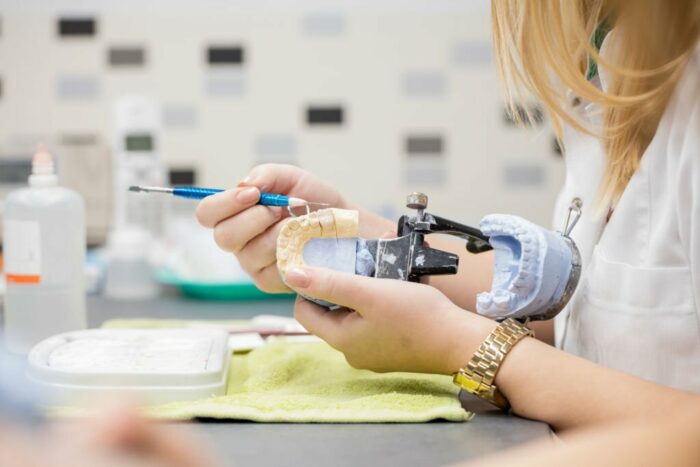Last Updated on January 24, 2025 by II Editor
The journey to becoming a dentist is a challenging and rewarding one, but it all begins with the crucial step of gaining acceptance into a dental school. Understanding dental school acceptance rates is the first key to embarking on this path. In this article, we will walk you through the factors influencing Acceptance Rates and dental school admission requirements. We will also give you a comprehensive understanding of the dental school acceptance rates to help you make the best decision on your career pursuit.
Understanding Dental School Acceptance Rates
Dental school acceptance rates are not mere numbers; they are vital metrics that shape the hopes and aspirations of aspiring dentists. In this section, we will delve into the fundamental concepts surrounding dental school acceptance rates, shedding light on what they are, how they are calculated, and the key factors that influence these rates.
What Are Dental School Acceptance Rates?
Dental school acceptance rates represent the percentage of applicants offered admission to a dental school within a specific application cycle. These rates are a reflection of the school’s selectivity and competitiveness, making them a crucial point of reference for prospective students. Acceptance rates are typically expressed as percentages and can vary significantly between institutions. They are an essential part of the decision-making process for applicants, as they help gauge the likelihood of gaining admission.
Acceptance rates are calculated by dividing the number of accepted students by the total number of applicants, and the result is expressed as a percentage. For example, if a dental school receives 1,000 applications and accepts 100 students, the acceptance rate would be 10% (100 accepted students divided by 1,000 applicants).
Factors That Influence Acceptance Rates
Understanding acceptance rates involves recognizing the multitude of factors that come into play. These factors influence how competitive a dental school’s admissions process is and why acceptance rates can vary widely from one institution to another. Here are some key determinants:
- Application Pool: The total number and quality of applicants impact acceptance rates. Highly prestigious dental schools often receive a larger pool of competitive applicants, making their acceptance rates lower. In contrast, less-known institutions may have higher acceptance rates due to smaller applicant pools.
- Admission Requirements: Each dental school sets admission requirements, such as GPA and DAT (Dental Admission Test) scores. Schools with stringent criteria tend to have lower acceptance rates as they admit students who meet these high standards.
- Geographic Location: Acceptance rates can vary by region, with some areas having more dental schools and, consequently, higher acceptance rates. Rural or less densely populated regions may have higher acceptance rates compared to densely populated urban areas. For instance, dental schools in California has a super lower acceptance rates when compared to other states.
- Program Type: Different dental schools may offer various programs, such as traditional DDS (Doctor of Dental Surgery) or DMD (Doctor of Dental Medicine) programs, specialty programs, or advanced standing programs. These variations can affect acceptance rates, as some programs may be more competitive than others.
- Diversity Initiatives: Dental schools often strive to foster diversity and inclusion in their student bodies. This may lead to variations in acceptance rates such as; out-of-state students, in-state and underrepresented minority groups as schools actively seek to increase their representation.
- Interview and Selection Process: The rigor and objectivity of a school’s interview and selection process can impact acceptance rates. Some schools have multi-stage selection processes that include interviews, while others rely solely on academic criteria.
Dental School Admission Requirements
The path to dental school acceptance is not solely determined by acceptance rates; it also hinges on meeting specific admission requirements that individual dental schools set. In this section, we will explore the critical admission requirements that aspiring dental students need to fulfill to become dentists.
GPA and DAT Scores
- GPA (Grade Point Average): Your undergraduate GPA is one of the fundamental criteria dental schools use to evaluate applicants. Most dental schools have a minimum GPA requirement, typically around 3.0 on a 4.0 scale. However, competitive applicants often have significantly higher GPAs, closer to 3.5 or above. Maintaining a strong GPA throughout your undergraduate studies is essential, as it demonstrates your academic competence and commitment.
- DAT (Dental Admission Test) Scores: The DAT is a standardized test that assesses your academic aptitude and scientific knowledge. Although a few dental schools do not require the DAT, most dental schools weigh DAT scores heavily in their admissions process. So, Scoring well on the DAT is crucial, and competitive scores often fall in the range of 19-30 or higher. Adequate preparation and practice are essential to achieve a competitive DAT score.
Letters of Recommendation
- Letters of Recommendation: Most dental schools require applicants to submit letters of recommendation. These letters typically come from professors, dentists, or other professionals who can vouch for your academic abilities, character, and suitability for dental school. It’s important to cultivate strong relationships with potential recommenders and give them ample time to craft compelling letters on your behalf.
Interviews and Personal Statements
- Interviews: Some dental schools conduct interviews as part of their admissions process. This is an opportunity for the admissions committee to get to know you, assess your communication skills, and gauge your commitment to the profession. Preparing for interviews, practicing common interview questions, and showcasing your passion for dentistry are key to success.
- Personal Statement: A personal statement is a written essay that allows you to convey your motivations, experiences, and aspirations. It is your chance to tell the admissions committee why you want to become a dentist and what makes you a strong candidate. Craft a compelling, well-structured personal statement highlighting your unique qualities and dedication to the field.
Understanding these admission requirements is vital for applicants. It’s important to remember that meeting these requirements is the first step. Dental schools receive thousands of applications; many applicants meet or exceed the minimum requirements. Therefore, to stand out, you should aim not only to meet these requirements but to exceed them, demonstrating your dedication, passion for dentistry, and unique qualities that make you a valuable addition to the dental school community.
In the upcoming sections, we will delve further into the admission process, exploring tips and strategies to excel in each of these requirements. By comprehensively understanding what dental schools are looking for, you can enhance your chances of securing a coveted spot in a dental program and taking the first step toward realizing your dream of becoming a dentist.
Application Process and Timeline
The application process for dental school is a well-structured and time-sensitive endeavor. In this section, we will provide a comprehensive overview of the dental school application process, detailing the various steps involved and the crucial timeline aspiring dentists must follow to ensure a successful application.
Overview of the Dental School Application Process
- Primary Application (ADEA AADSAS or TMDSAS): The first step in the application process is to complete the primary application. In the United States, most dental schools use the American Dental Education Association Application Service (ADEA AADSAS) for applicants to allopathic (U.S.) dental programs or the Texas Medical and Dental Schools Application Service (TMDSAS) for Texas dental schools. These services allow you to submit a single application to multiple dental schools, streamlining the process.
- Transcripts and Letters of Recommendation: You will need to submit your official transcripts from all post-secondary institutions attended—additionally, request letters of recommendation well in advance. Aim for letters from professors, mentors, or dental professionals who can attest to your qualifications and character.
- Dental Admission Test (DAT): Ensure that you have taken the DAT and that your scores are sent to the schools to which you are applying.
- Secondary Applications: After receiving your primary application, some dental schools will send secondary applications with additional essays and information. Be prepared to complete these promptly.
- Interviews: If selected, you may be invited for interviews at the dental schools. These interviews provide an opportunity for the admissions committee to get to know you better and assess your suitability for their program.
- Acceptance and Waitlist Notifications: Dental schools typically begin sending out acceptance and waitlist notifications as early as December and continue through the spring and summer months.
Key Application Deadlines
Understanding the dental school application process timeline is vital to ensuring that you meet all deadlines. The application cycle for dental schools typically follows this schedule:
- Spring and Summer Before Application Year (1-2 years prior):
-
- Prepare for and take the DAT.
- Research dental schools and compile a list of potential programs.
- Late Spring/Early Summer Before Application Year (1 year prior):
-
- Begin working on your primary application through ADEA AADSAS or TMDSAS. This typically opens in May or June.
- Summer/Fall Before Application Year (1 year prior):
-
- Request transcripts and letters of recommendation.
- Complete and submit the primary application as early as possible.
- Be prepared to complete secondary applications if they are sent to you.
- Fall/Winter Before Application Year (1 year prior):
-
- Be attentive to interview invitations, which may start as early as late summer or early fall.
- Late Fall/Early Winter Before Application Year (1 year prior):
-
- Keep track of acceptance notifications, which can begin in December.
- Spring/Summer of Application Year:
-
- If accepted, submit your deposit to secure your spot.
- If waitlisted, continue to express your interest in the program and provide updates as appropriate.
Understanding this timeline and being prepared for each stage of the application process is crucial. Missing deadlines or failing to meet requirements can significantly impact your chances of admission. Additionally, remember that some schools may have unique deadlines, so always check with individual programs for their specific requirements.
In the section below, we have painstakingly compiled a list of dental school acceptance rates in the United States.
List of Dental School Acceptance Rates in the US
Below is a curated list of the dental school acceptance rates in the United States, which we have included alongside their average GPA and the DAT scores.
| Institution | Acceptance Rates | Average GPA | Average DAT |
| Arizona School of Dentistry & Oral Health | 2.2% | 3.4 | 19.0 |
| Augusta University | 10% | 3.6 | 19.0 |
| Boston University | 2.5% | 3.4 | 20.0 |
| Case Western Reserve University | 2.67% | 3.6 | 19.6 |
| Columbia University | 3.33% | 3.5 | 22.4 |
| Creighton University | 3.4% | 3.6 | 19.3 |
| East Carolina University | 13.75% | 3.4 | 18.0 |
| Harvard University | 3.18% | 3.8 | 23.0 |
| Herman Ostrow School of Dentistry | 4.26% | 3.5 | 20.0 |
| Howard University | 3.75% | 3.2 | 17.4 |
| Indiana University | 7% | 3.5 | 19.1 |
| LSU Health Sciences Center | 9.28% | 3.6 | 19.0 |
| Lake Erie College of Osteopathic Medicine (LECOM) | 5% | 3.74 | 21.0 |
| Loma Linda University | 4.75% | 3.3 | 19.9 |
| Marquette University | 4% | 3.6 | 20.0 |
| Medical University of South Carolina | 7.89% | 3.6 | 20.0 |
| Meharry Medical College | 3.4% | 3.2 | 17.0 |
| Midwestern University – AZ | 4.6% | 3.6 | 19.0 |
| Midwestern University – IL | 4.48% | 3.4 | 19.0 |
| Missouri School of Dentistry & Oral Health | 4.5% | 3.4 | 18.0 |
| New York University | 7.4% | 3.5 | 21.0 |
| Nova Southeastern University | 4% | 3.67 | 20.0 |
| Ohio State University | 11% | 3.7 | 20.5 |
| Oregon Health & Science University | 5.7% | 3.7 | 20.0 |
| Roseman University of Health Sciences | 4% | 3.3 | 20.0 |
| Rutgers School of Dental Medicine | 4.5% | 3.5 | 20.4 |
| Southern Illinois University | 8.3% | 3.7 | 19.0 |
| Stony Brook University | 3.07% | 3.5 | 21.0 |
| Temple University | 3.47% | 3.5 | 20.0 |
| Texas A&M University | 5.88% | 3.6 | 20.0 |
| Touro College of Dental Medicine | 5.23% | 3.5 | 20.0 |
| Tufts University | 2.1% | 3.4 | 20.0 |
| UT Health San Antonio | 6.6% | NA | 20.0 |
| University at Buffalo, School of Dental Medicine | 5% | 3.5 | 20.0 |
| University of Alabama, Birmingham | 8.66% | 3.7 | 20.0 |
| University of California, Los Angeles | 4.5% | 3.7 | 22.0 |
| University of California, San Francisco | 4.7% | 3.5 | 21.0 |
| University of Colorado | 5.33% | 3.6 | 20.0 |
| University of Connecticut | 3.2% | 3.6 | 20.7 |
| University of Detroit – Mercy | 8.05% | 3.7 | 21.0 |
| University of Florida | 6.33% | 3.7 | 20.0 |
| University of Illinois, Chicago | 3.33% | 3.47 | 19.8 |
| University of Iowa | 8% | 3.8 | 20.0 |
| University of Kentucky | 3.6% | 3.5 | 19.0 |
| University of Louisville | 4% | 3.5 | 19.0 |
| University of Maryland | 4.6% | 3.5 | 20.4 |
| University of Michigan | 5.25% | 3.6 | 20.0 |
| University of Minnesota | 9.16% | 3.6 | 20.4 |
| University of Mississippi | 31.81% | 3.7 | 18.0 |
| University of Missouri, Kansas City | 11.57% | 3.6 | 19.0 |
| The University of Nebraska Medical Center | 6.25% | 3.8 | 19.0 |
| University of Nevada, Las Vegas | 3.86% | 3.4 | 20.1 |
| University of New England | 5.41% | 3.4 | 18.0 |
| University of North Carolina | 5.33% | 3.5 | 21.0 |
| University of Oklahoma | 8% | 3.6 | 20.3 |
| University of Pennsylvania | 5% | 3.7 | 21.0 |
| University of Pittsburgh | 3.8% | 3.6 | 20.1 |
| University of Puerto Rico | 10% | 3.5 | 17.0 |
| The University of Tennessee Health Science Center | 7.2% | 3.6 | 20.0 |
| The University of Texas at Houston | 6.6% | 3.7 | 19.6 |
| University of Utah | 2.5% | 3.8 | 21.0 |
| University of Washington | 6.13% | 3.7 | 21.0 |
| University of the Pacific | 5.1% | 3.6 | 22.0 |
| Virginia Commonwealth University | 4% | 3.6 | 20.0 |
| West Virginia University | 5% | 3.5 | 18.0 |
| Western University of Health Sciences | 2.54% | 3.3 | 20.0 |
Conclusion
Your journey to dental school is a testament to your passion for dentistry and your unwavering commitment to improving oral health. While the path may be challenging, the rewards are immeasurable. By arming yourself with knowledge, preparation, and a proactive approach, you can achieve your dream of becoming a dentist and embark on a fulfilling and impactful career in oral healthcare. Your journey begins with understanding the landscape, mastering the application process, and staying true to your aspirations. Good luck on your path to dental school and beyond!










